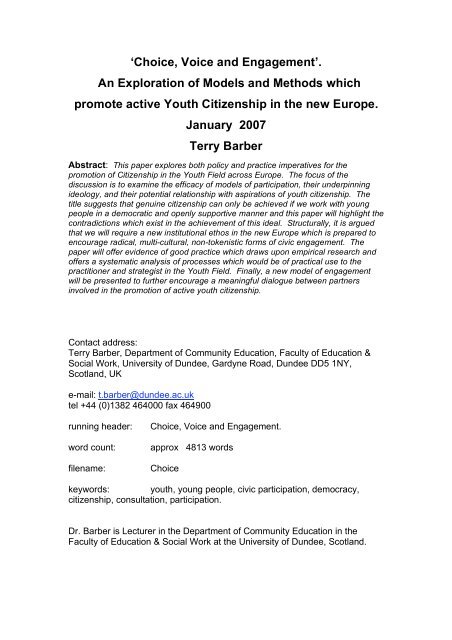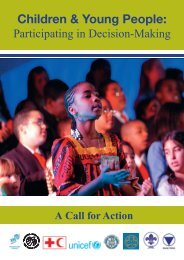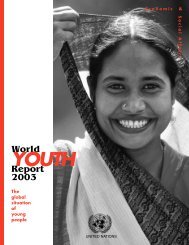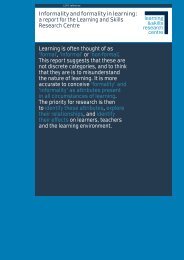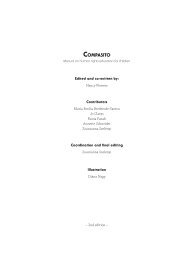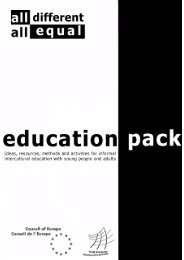Download Terry Barber's paper here. - European Citizenship
Download Terry Barber's paper here. - European Citizenship
Download Terry Barber's paper here. - European Citizenship
You also want an ePaper? Increase the reach of your titles
YUMPU automatically turns print PDFs into web optimized ePapers that Google loves.
‘Choice, Voice and Engagement’.An Exploration of Models and Methods whichpromote active Youth <strong>Citizenship</strong> in the new Europe.January 2007<strong>Terry</strong> BarberAbstract: This <strong>paper</strong> explores both policy and practice imperatives for thepromotion of <strong>Citizenship</strong> in the Youth Field across Europe. The focus of thediscussion is to examine the efficacy of models of participation, their underpinningideology, and their potential relationship with aspirations of youth citizenship. Thetitle suggests that genuine citizenship can only be achieved if we work with youngpeople in a democratic and openly supportive manner and this <strong>paper</strong> will highlight thecontradictions which exist in the achievement of this ideal. Structurally, it is arguedthat we will require a new institutional ethos in the new Europe which is prepared toencourage radical, multi-cultural, non-tokenistic forms of civic engagement. The<strong>paper</strong> will offer evidence of good practice which draws upon empirical research andoffers a systematic analysis of processes which would be of practical use to thepractitioner and strategist in the Youth Field. Finally, a new model of engagementwill be presented to further encourage a meaningful dialogue between partnersinvolved in the promotion of active youth citizenship.Contact address:<strong>Terry</strong> Barber, Department of Community Education, Faculty of Education &Social Work, University of Dundee, Gardyne Road, Dundee DD5 1NY,Scotland, UKe-mail: t.barber@dundee.ac.uktel +44 (0)1382 464000 fax 464900running header:word count:filename:Choice, Voice and Engagement.approx 4813 wordsChoicekeywords: youth, young people, civic participation, democracy,citizenship, consultation, participation.Dr. Barber is Lecturer in the Department of Community Education in theFaculty of Education & Social Work at the University of Dundee, Scotland.
IntroductionAny meaningful discussion on youth citizenship must acknowledge the factthat as a concept it is hugely contested and potentially open to contaminationand vested interest distortion. In terms of definition it must be influenced byrelatively complex notions of state intervention, the market, the common goodand rights and obligations mostly prescribed by the ‘moral majority’. In manyways the march of globalisation, consumerism and the ascendancy ofcapitalism across the new Europe adds to this complexity. Despite thesecontradictions, this <strong>paper</strong> will present a mainly positive analysis of youthcitizenship and its potential to liberate new thinking and action in the field ofyouth work. The urgency of this debate relates to the very heart of the<strong>European</strong> Union in the shape of the Treaty of Rome with its three foundationprinciples of liberty, equality and social justice. Europe is in a state of fluxdriven by the aspirations of emergent democracies, a movement towardscentrist politics and societies in transition. Accepting the EU as it is (acquiscommunautaire) may need to be revised in the light of unequal accessopportunities for young people aspiring to new forms of citizenship.In this <strong>paper</strong> I would firstly like to explore perspectives on citizenship which Ibelieve influence our understanding of effective youth work and the positivedevelopments we seek. Secondly, I will examine the utility of participationmodels and their applicability in a modern democratic Europe. Finally, I offerfield-based insights which I believe will contribute to the youth citizenshipdebate and the development of skilled practice in this critical area.What Do We Mean By <strong>Citizenship</strong>?The origins of citizenship can be traced back through the philosophical andpolitical traditions most prolific in the civic structures of ancient Greece andthe Roman Republics. The rights responsibilities and civic sense of duty wereseen as core to a social order aspiring to notions of democracy, polis (citystates) and the emerging patterns of civitas (citizenhood). Developing ideasand rules of engagement relating to citizenship meant being able toparticipate in the shaping of decision-making and state laws which was seen1
to benefit all. This early form of common good was very much focused uponthe political nature of participation, dialectics and contradiction.In more recent times the democratic ideals have developed through shifts inthe social structure away from a minority property owning educated citizenryto a wider populace. The demands for an extended franchise and an openingup of government have all been the result of citizen struggle within ouremerging democracy. The contemporary view of citizenship is one thatdescribes adult rights as a citizen and responsibilities within a framework ofcommunity or state membership. This is held together under a system ofrepresentative democracy. Young people in the main have not beenencouraged to get involved in adult decision making because of theirperceived lack of maturity and some would argue that this is the central issuewithin any genuine debate on Youth citizenship (see Cardiff Declaration,2005) To be ‘seen and not heard’ has perhaps more meaning than werealise. The development of citizenship for young people is somewhatcontradictory.France (1996:28) observes that:“The re-structuring of citizenship for the young is the growth anddevelopment of new forms of social controls, which limit youngpeople’s choices and restrict their opportunities to become autonomousadults”. (p28)From the outset this perspective alerts us to the fact that the concept may beopen to contamination. France cites a number of examples to support hisargument including the detrimental changes in benefit entitlements for youngpeople and the increasing dependency on the family for both advantaged anddisadvantaged youth. To enable us to examine more critically the concept ofcitizenship and how it relates to participation it would be useful to establishsome working definitions.The classic contemporary analysis by Marshall (1950) in his work is a usefulstarting point for any meaningful analysis of citizenship. Marshall argues froma reformist perspective, which suggests that social policy reform can2
challenge the worst aspects of economic and social inequality. The threecore elements of citizenship he describes are:• Civil rights• Political rights• Social rightsThe civil elements are made up of the right to encourage individual freedom,freedom of speech, thought and faith. The right to own property concludecontracts and the right to justice. The political element asserts that peoplehave the right to vote, join a political body of their choice and influence theinstitutions of the state. The social element relates to the right to expecteconomic welfare and security as well as the right to….“share to the full in thesocial heritage and to live the life of a civilised being according to thestandards prevailing in society” (p.249). For Marshall, the institutions mostlikely to uphold these values were the education system and social servicesresponding to the needs of the community in general. The perspective citesthe expansion of citizen’s rights from the eighteenth century, culminating inthe redistribution achievements of the post war welfare state. The implicationwas that citizenship could counterbalance the negative effects of capitalismand the so-collect free market.“The dynamic of class inequalities stemming from the capitalist marketorganisation of society can be moderated to some degree. The worstexcesses of class inequality can be successfully ‘abated’ through theexpansion of democratic social rights”. (p244)The concept of citizenship is contested by many. Willow (1995) hasdeveloped an explanatory framework, which draws upon Marshall’s three coreelements but with a clear focus on participation by young people as themeans to real citizenship.The Political CaseThe so-called democratic deficit is often highlighted as a major outcomearising out of youth alienation and disenchantment. At the last UnitedKingdom election in 2005 only 37% of eligible 18-24 year olds voted. Perhapsmore disturbingly the number of young people who said they actually carewho wins the next election fell from 68%in 1994 to 39% in 2003. (MORI 2005)3
The Legal CaseThis focuses primarily upon the United Nations Convention on the Rights ofthe Child as ratified in 1991 by the UK Government. The ratification is adeclared intention that law, policy and practice will be compatible with theprinciples and standards of the convention; of which 40 of the 54 articlesascribe direct rights to those under 18 years. Willow categorises Legal rightsunder three headings:• participation rights• protection rights• provision rightsThe Social CaseThe case for participation as advocated by Willow involves debunking theidealised picture of childhood w<strong>here</strong> young people are presented as havinglittle to say or do except play. Instead she draws on empirical data whichhighlights the fact that young people have real concerns which to a greatextent mirror the adult community but also display a greater sense of urgencye.g. bullying, parental arguments, violence etc. Whilst acknowledging the factthat young people may not always have the skills, knowledge or experience tomake decisions at all levels, Willow argues in favour of Article 5 of theConvention that we should a nurture child’s ‘evolving capacities’ (p13). Thisoffers a much more dynamic alternative for those services involved in youthparticipation.In many adult dominated ‘learning’ situations young people have beenpassive consumers receiving the wisdom of their elders. Is it any wonder thatthey quite often mistrust this new liberatory approach? Moir (1999:16)contrasts both stances well:“The liberatory approach is concerned with the development of critical andreflective thinking and understandings about the nature and complexity ofthe world they live in, creating the opportunity to take action for change.Education in this approach is not assumed to be neutral.Conversely…on domestication…..he writes…..At the root of this model(domestication) is the assumption that young people are in some way4
deficient, and can be made good by youth work. The political, social,economic and cultural issues which directly impact on and shape their livesare largely ignored”.(p16)A radical shift in the cultural ethos of learning institutions such as schools,colleges and universities will demand a new way of working which is far moreinteractive and democratic; genuinely working with, as opposed to for, youngpeople. A more creative stance which ‘embraces uncertainty’ and nurturescritical dialogue will be the new guiding dynamic (Taylor and White 2001;Pease, 2002). This transformation will have substantial implications forinstitutions across Europe engaging with young people. The majorgovernment initiative exploring citizenship led by Crick (1998:10) outlines thegoals for addressing this deficit.“We aim at no less than a change in the political culture of this countryboth nationally and locally; for people to think of themselves as activecitizens, willing, able and equipped to have an influence in public lifeand with the critical capacities to weigh evidence before speaking andacting, to build on and to extend radically to young people the best inexisting traditions of community involvement and public service, and tomake them individually confident in finding new forms of involvementand action among themselves”.(p10)Empirical research suggests that t<strong>here</strong> is a significant pre-occupation withsocial disengagement and youth apathy without full recognition of the socialinequity faced by a significant number of young people. This theme isdeveloped by Williamson (2005:13) in his proposition that we need to betterunderstand the ‘mutuality’ principle as a necessary pre-condition for activeengagement.“<strong>Citizenship</strong> does not materialise at a particular chronological pointthrough a simple rite of passage. <strong>Citizenship</strong> is the product of aprocess – one based on a mutual relationship between the individualand community. It is contingent on a fundamental sense of belongingto a community….the reasons some young people fail to engage with5
their communities is that they feel these communities have rejectedthem. Feelings are as important as knowledge and skills”.(p13)T<strong>here</strong> is a growing populist consensus (most evident in the United Kingdom)that in our efforts to enable more effective participation and youth citizenshipwe have overemphasised rights at the expense of responsibilities. The focusis t<strong>here</strong>fore firmly embedded in our understanding of what constitutes a ‘goodcitizen’. Young people are perceived as ‘deficient citizens’ (Eden and Roker,2002). Extensive longitudinal research carried out over a three year periodexamining transitions into citizenship reveal a much more positive picture withyoung people taking very seriously their responsibilities to community andsociety (Lister, Smith, Middleton, Cox, 2005:33). Perhaps we need to fullyunderstand the difference between that which is ‘citizenlike’ and ‘citizenship’itself. Being citzenlike implies an altruistic, helping, but more passiveapproach to social change. <strong>Citizenship</strong> is potentially a more political formwhich could involve challenging the status quo actively. Sparks (1997:75)Refers to the notion of ‘dissident citizenship’“‘dissident citizenship describes oppositional democratic practicesthrough which dissident citizens constitute alternative public spaces topursue non-violent protest outside the formal democratic channels”.(p75)The conceptualisation of Youth <strong>Citizenship</strong> across Europe must capture thesocial, cultural and economic landscape which supports the rights andresponsibilities of young <strong>European</strong>s or in some cases fails them. This mustbe the focus of the open method of consultation (OMC) currently beingimplemented across Europe. Kerr (2003:2) following the work of Jenson, et al(1996) represents a challenge which could contribute to a more holisticunderstanding of how to achieve citizenship in modern day Europe.Diversity - of living in increasingly socially and culturally diversecommunities and societiesLocation - of the nation-state no longer being the 'traditional location'of citizenship and the possibility of other locations within and across6
countries, including notions of '<strong>European</strong>', 'international', 'transnational'or 'cosmopolitan' citizenship.Social rights - of changes in the social dimension of citizenship broughtabout by the impact of an increasingly global economyParticipation - of engagement and participation in democratic societyat local, national and international levelsThe ideology of ‘third way’ politics in Europe draws upon a social democraticphilosophy of governance which in many ways is entirely compatible withprogressive forms of youth citizenship. Central to the Lisbon strategy (2000) isthe notion of a ‘knowledge economy’, based on innovation and new forms ofdemocratic governance. Youth <strong>Citizenship</strong> is not a luxury but a necessaryprerequisite to the achievement of this ideal. A more devolved governmentwhich champions deregulation, decentralisation and the renewal of civilsociety is something we all seek, but if this style of government perpetuates a‘deficit’ model of citizenship based upon a fear of young people then it mustbe challenged. In the United Kingdom the Anti-Social Behaviour Orders werenot primarily designed for dealing with young people exclusively but the realitymay be different for most people. Curfews, Tagging and advancedsurveillance techniques have added to this ubiquitous fear of young peoplewhich although never wholly intentional, has become the product of NewLabour’s Third Way.T<strong>here</strong> are very real dangers that some aspects of Youth Work become moresurveillance based than working with young people in a process driven,relationship based manner. Davies (2005) summarises this potential‘disproportionality’ in current youth policy making:“ In the youth policy field what is crucially different from the 1960s isthat today a strategy is being developed based on deliberatelyexploiting popular tensions and frustrations – on playing directly on fearand prejudice. The result is to encourage blanket demonising anddehumanising of a whole generational segment of the population byresort to, and then the widespread and continual recycling of, labels7
such as ‘yob’ and ‘feral youth’. In order to turn the full weight of thestate against these demons, disproportionate public and policyresponses are then endorsed, which involve serious distortion of theoperation of judicial and law enforcement procedures”. (p7)It is critical that we challenge the ‘deficit’ model in our work with young peopleand youth work practitioners. The ‘structured dialogue approach’ (see<strong>European</strong> Youth Forum, 2006), involving diverse interests in the youth fieldmay have real utility. T<strong>here</strong> is evidence to suggest that young people areembracing new modes of communication using web based frameworks whichhave the potential to re-invent or remix citizenship in a way we could neverhave imagined a decade ago (see Coleman, 2005). The so called ‘apatheticgeneration’ may be constructing something very, very special.YOUTH CITIZENSHIP AND PARTICIPATIONIf Youth <strong>Citizenship</strong> is the end we seek in our work with young people, activeparticipation is the primary means for achieving this end. This <strong>paper</strong>acknowledges the work of Hart (1992); Treseder (1997) and others concernedwith authentic participation but for my purposes I would like to focus uponArnstein (1969) and Shier (2001). In 1969 Sherry Arnstein produced atypology of participation. This adopted a controversial stance by suggestingthat public participation in planning and power sharing was flawed at best.The focus of Arnstein’s attention was the poor practice she observed in herown work and the work of others seeking the meaningful engagement ofexisting and potentially new participants. Her ladder of participation, models aframework from the bottom rung of manipulation through to aspirations ofcitizen control. (See Figure 1) Manipulation and therapy were perceived aswindow dressing or a form of cosmetic public relations exercise, whilstinforming, consulting and placating were seen to be tokenistic forms ofpreserving the uneven distribution of power.8
Arnstein highlighted key limitations in her ladder typology, acknowledging thatin the real world t<strong>here</strong> could be hundreds of rungs on a particular ladder with aprogression up or a regression down, depending on the context and t<strong>here</strong>silience of power holders. T<strong>here</strong> is also some contemporary resonance inher observations of how to de-skill opposition by encouraging a form ofpseudo-participation which appears to promote consensus and in some casescompliance.9
Figure 1. Arnstein’s ‘ladder of citizen participation’Included in this level are programmes which giveEighth rungCitizen controlpower and control to citizens.Seventh rungSixth rungFifth rungFourth rungThird rungSecond rungBottom rungDelegated powerPartnershipPlacationConsultationInformationTherapyManipulationCitizens have significant control. If disputes arise,citizens enter into a bargaining process withofficials rather than officials deciding outcomes.Planning and decision-making is shared at thislevel.Tokenistic exercises such as allowing a smallnumber of selected people to become members ofofficial committees, with no real intent toredistribute power or resources.This can be a step toward full participation butconsultation alone is not enough to secure citizenparticipation in ensuring that ideas and opinions arecarried into action.Information can be a precursor to full participationbut one-way flow of information is ineffective infinding out people’s views.Here citizens are encouraged to join groups toshare their experiences - this level serves topathologise individuals while leading to little socialchange.Here citizens are placed on ‘rubber-stamp’committees to give the appearance of consultationand participation.10
The ladder of participation in some ways is stereotypical, presenting stageswith little reference to context and this has led many critics to perceive it as anover-simplistic generalisation. In its time, it presented practitioners with auseful model through which they could reflect on their own practice and theintent of their employing agencies more radically. Were they actually enablingyoung people to participate effectively or were they indeed ‘agents of socialcontrol’?The strengths of Arnstein’s model lie in its accessibility. Having a sense ofthe graduations involved in citizen participation is a useful starting point fordeveloping genuine partnerships. The weaknesses relate to the assumptionsit makes about progression from one stage to another. The participation ofyoung people is more dynamic, unpredictable and situation specific than themodel suggests. Also, given that a great deal of valuable work across theyouth field in Europe is actually focused on consultation, is it fair to accept thatthis is approach is somehow inferior? Bell (2004) enables us to be clearerabout the distinctiveness of each approach by defining with some precision,involvement, consultation and participation.‘Involvement’ is a generic or umbrella term covering a range of activities.These can include information giving and receiving and consulting on specificissues. It does not define the extent of power young people may have toinfluence the process or outcomes.‘Consultation’ can mean many things from adult-led activities aimed atexploring opinions that may be acted upon later, to approaches thatencourage and support child-initiated and child-driven approaches and selfdetermination.Consultation can be undertaken on a large formal scale or on apersonal, informal level. It is often equated with participation – but crucially, itis usually adults who hold the power to decide what to do with the information.‘Participation’ refers to young people taking an active part in a project orprocess, not just as consumers but as key contributors to the direction andimplementation of work carried out. Young people are proactive in thisprocess and have the power to help shape the process – their views have the11
same weight as the adults they are working alongside. Participation refers tochildren's and young people's involvement in decision-making, whatever formthis may take. Consultation means deliberately asking children and youngpeople about their views. These views may or may not be incorporated intopolitical decision-making. Contemporary approaches in <strong>European</strong> youth fieldhave built on the work of Arnstein and others and have focused on thestructural readiness of organisations to involve young people authenticallywith varying degrees of success. The recognition that young people havebeen largely excluded by dominant structures and discourses is welldocumented (Prout, 2001, 2002; Smyth, 1999).Shier (2001) is a good example of this change in emphasis, from the young personto the organisational culture and its capacity to involve young people (children)democratically. Shier’s model outlines five levels of participation. At each level theindividual has different degrees of commitment. The ‘choice’, ‘voice’ and‘engagement’ methods are critical in this regard.This is clarified by identifying three stages of commitment at eachlevel….openings…opportunities…and obligations. Shier describes these discretebut interconnected stages as follows. The openings describe the stance of theworker who makes a genuine commitment to working democratically with theyoung person. This could take the form of a statement of intent and does notnecessarily mean anything other than solid relationship building. The opportunitystage focuses upon the infrastructure to support practice. This could includeresources, training and more participative systems within the organisation. Theobligation stage models the existence of built in systems within the organisationw<strong>here</strong> democratic participation becomes a policy norm which is reflected in a newway of working with young people. The model (See Figure 2) is based on fivelevels of participation which are:1 Children are listened to2 Children are supported in expressing their views3 Children’s views are taken into account4 Children are involved in the decision-making process5 Children share power and responsibility for decision-making12
Figure 2. Shier's (2001) Pathways to Participation13
The model proposed by Shier is in contrast to other hierarchical participationmodels in that it focuses not only on what young people need to do toprogress, but importantly what the organisation needs to do to createparticipative access. Encouraging young people to be vocal can beproblematic and this weakness can often be manipulated by adults whoengage in filtering what they have to say; a form of pseudo Youth <strong>Citizenship</strong>perhaps. Fine (1994:19) refers to this phenomenon as “ventriloquism”. In theShier framework t<strong>here</strong> is an opportunity to challenge this by posing keyquestions as a potential audit function for organisations using the model. Thelinkage with the UN convention on the rights of the child and other Eurowidepolicies also adds to the potential application of the model.T<strong>here</strong> is currently an interesting shift taking place in practitionerunderstanding of what appears to influence disengagement by young people,from societal institutions in general. The core characteristics identified bytheorists in this area (Brent, 2004; Davies and Docking, 2004) suggest theneed to “actively embrace the young people’s collective identities and seek tohelp them assert these identities more confidently” (Davies, 2005p18)Historically, we have focused our attentions on a participation gap, fed by alack of confidence or motivation in young people. The intention was alwaysthat a fully participating young person, supported by a nurturing adult or two,would somehow influence the structure in such a way that real change wouldresult over time. The reality has been that structure in general has resistedthis change and many young people and practitioners have becomedisillusioned in the process.Many commentators working in policy and practice now challenge themythology of youth disengagement and to some extent the acceptance ofyouth sub-culture as a defining metaphor (Bennett, 2004; Muggleton, 2000).Coleman (2005) describes the phenomenon as ‘mass generational migrationfrom old-fashioned forms of participation to newer more creative forms’. (p2).The link with Youth <strong>Citizenship</strong> is obvious.14
In my own practice in the youth field I have always found it useful to exploreexactly who youth work is for? Is it for those who seek to control youngpeople or those who enable them to achieve their fullest potential? Thefollowing dialogue model of youth engagement is offered as a basic trigger fordiscussion by those seeking to explore short, medium and long term changein the youth citizenship context. (See Figure 3)15
Figure 3 THE TB (Top-Down/Bottom Up) MODEL OF YOUTHENGAGEMENT. Barber (2006)AdultisingControlFearTHE ENGAGEMENT ZONEIdentityRisk TakingDevelopingCapacitiesTop-Down Pressures16
Top – Down PressuresThis area of the model focuses on the structural and societal pressures facingyoung people and those who work with them. Recent empirical researchcarried out by Barber and Naulty (2005) in the United Kingdom contextsuggests that top-down, structural understanding of young people is stilllargely driven by fear and the need to control.Adultising… refers to behaviour by adults who do not fully accept youngpeople as they are. Instead t<strong>here</strong> are great efforts (sometimes overt,sometimes manipulative, paternalistic and hidden) which seek to acceptyoung people only if they mimic ‘responsible’ adult values and behaviour. Agreat deal of the window dressing and politically populist programmessubscribe to this approach.Control…refers to the much held view that young people must be kept incheck at all costs if social order is to remain intact. A spectrum of controlranges from soft socialisation in institutions such as the school and the familyunit through to more coercive tactics by the more negative elements of statecontrol.Fear…. refers to the socially constructed perception of youth as synonymouswith rebellion and deviancy. Fear of young people is a global phenomenon,quite often finding expression in moral panics in society and community.Bottom-Up PressuresThis area describes the aspirational pressures exhibited by young people inthe process of engagement.Identity - Finding Self, Being Self…..refers to the need for young people todevelop their own identity internally and through social interaction with othersin a diverse range of contexts.Risk Taking….The possibility of challenging the status quo and the ‘wisdom’of adults is a fundamental part of being young. How this finds expression is a17
matter of debate. Those working with young people need to understand thisprinciple if they are to relate effectively.Developing Capacities…proposes that young people are in a state oftransition; their needs, wants and capabilities in a high state of flux.Recognition that young people need emotional and physical space to workthis through with adults and peers who respond congruently is essential.The Engagement ZoneThis is the term for the dynamic context w<strong>here</strong> adults engage and interact withyoung people and structure meets personal agency. The zone is the place fordialogue, compromise, insight and a focus on possibility. In this area t<strong>here</strong>will be expression of anger, cynicism, tokenism, humour, creativity andpositive change. Some adults and young people will leave the zone whenthey feel that their needs are not met; some will remain and continue tostruggle optimistically in the hope that change can be achieved.The TB engagement model is a representation of complex processes but it ishoped that those committed to genuine Youth <strong>Citizenship</strong> work with youngpeople can use it as a prompt for discussion and dialogue. Not all top-downpressures are negative. In fact some structural forces can, in the rightcontext, be productive and developmental. The demands from bottom upsimilarly cannot be assumed to be positive and altruistic. The pressures fromyoung people in some ways may be unrealistic, unattainable and naïve. Whatremains in the zone is the commitment to listening and dialogue betweenadults and young people.ConclusionsThe promotion of Youth <strong>Citizenship</strong> in a new Europe is closely allied to a new‘zeitgeist’ arising out of changing aspirations, ways of communicating andways of being. The dominating and sometimes paternalistic attitudes of themoral majority are unlikely to be attractive to young <strong>European</strong>s. Restructuringacross nation states, patterns of migration, mobility and a fracturing of culturalhomogeneity will feed demands for Youth <strong>Citizenship</strong> as a distinctive18
movement. The <strong>European</strong> Youth Pact (2005) has the potential to ground theideals of the Lisbon strategy and influence youth policy development andultimately practice in the youth field. T<strong>here</strong> is a need to understand theproblematic nature of moving from a state of dependence to adultindependence in forms of Youth <strong>Citizenship</strong> ‘Status ambiguity’ refers to thephenomenon of not knowing the extent of your own rights and responsibilitiesand this has significant effects on the sense of purpose felt by both adults andyoung people (Moore and Rosenthal, 1995p234). Coleman (2004) developsthis theme:“The question of ‘status ambiguity’ is a key one because of what ittells us about the balance of power in the relationship betweenadults and young people. If the individual’s status is ambiguous,and if his or her rights are not clearly defined, then inevitably he orshe will lack the power to influence events and to take control of hisor her life……it is essential that we recognise the effects of theinequality between the generations. Effective communicationinvolves the creation of a relatively equal interaction, with give andtake between both participants”. (p228)Those with influence in the youth field need to move beyond economisticand consumerist notions of youth relying solely upon vocational skilldevelopment. T<strong>here</strong> is a need to actually embrace ‘soft skill’development more fully if we are to nurture genuine choice, voice andmore radical forms of engagement. The capacity to function effectivelyas a young citizen relies upon the development of positive relationships,tolerance and creative resilience in action. The movement of positivedemocratic change needs to be grounded in the policies and practice ofall of those who work with young citizens towards the building of a more‘possibility-seeing’ Europe.19
<strong>European</strong> Youth Forum (2006) Policy Paper on the Future of EU YouthPolicy Development.Eden, K And Roker, D (2002) ‘Doing Something’..Young People AsSocial Actors. Leicester: Youth Work Press.Fine, M. (1994). 'Dis-stance and other stances: Negotiations of powerinside feminist research'. In A. Gitlin (Ed.), Power and method: Politicalactivism and educational research (pp.13-35). New York: Routledge.France, A. (1996) Youth & <strong>Citizenship</strong> In The 1990’s. Youth and Policy,53, 28-43. Leicester: National Youth Agency. Youth Work Press.Hart, R.A. (1992) Children’s Participation: From Tokenism to<strong>Citizenship</strong>. (Innocenti Essays) No. 4. London: United NationsInternational Children’s Emergency Fund.Kerr, D. <strong>Citizenship</strong> Education in England: The Making of a NewSubject - Journal of Social Science Education (JSSE) 2/2003Marshall, T.H. (1950a) <strong>Citizenship</strong> and Social Class. Cambridge:Cambridge University Press.Moir, S. (1999) Theory In Practice, Towards A Critical Pedagogy OfYouth. In Conceptualising Youth Work. Edinburgh: Concept Publishing.MORI, Market and Opinion Research International (2005) in BritainToday’ The British Journal of Politics and International Relations, 4(2),167–192.Moore,S and Rosenthal, D. (1995). Sexuality in Adolescence. London:Routledge.Muggleton, D. (2000) Inside Subculture: The Post-Modern Meaning ofStyle. Oxford: Berg.Pease, B. (2002) ‘Rethinking empowerment: A postmodern reappraisalfor emancipatory practice’. British Journal of Social Work, 32(2), p135-47.Shier, H. (2001) ‘Pathways to participation: Openings, opportunitiesand obligations. A new model for enhancing children’s participation indecision-making, in line with Article 13.1 of the UNCRC’, Children &Society, 15, 107-117.Sparks, H. (1997) ‘Dissident <strong>Citizenship</strong>: democratic theory, politicalcourage, and activist women’, Hypatia, 12 (4): 74-110.21
Taylor, C. and White, S. (2000) Practising Reflexivity in Health andWelfare: Making Knowledge. Buckingham, Open University. Treseder, P. (1997) Empowering Children and Young People. TrainingManual. London: Save the Children. United Nations Convention on the Rights of the Child. (1989). GeneralAssembly resolution 44/25. Williamson, H. (2005) In Young People Now. February 2005.Leicester: Haymarket. Willow, C. (1997) Hear! Hear! Promoting Children and Young People'sDemocratic Participation in Local Government. Local GovernmentInformation Unit Press.22


